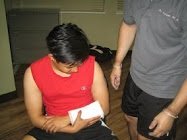Overview Of Puncture Wounds
Slight puncture wounds can be treated successfully in the comfort of your home. If you do not have an increased possibility of infection, you don’t have any other wounds, and you do not need a tetanus injection or treatment by a GP, then you can manage and care for a puncture wound by yourself. Home treatment can stop infection and encourage healing. It is suggested that everybody use proper precautions when executing first aid treatment.
Removing The Object
- Be certain the item causing the injury is not still lodged in the wound. Look to see if the item is intact and a portion has not fragmented in the wound.
- Try to get rid of the item that caused the wound if it is small enough. Be cautious, and do not shove the item especially if the item is lodged in the eye. You should also try not to get the splinter wet.
Control The Bleeding

- Permit the wound to drain for up to 5 minutes so the wound can clean itself out, except if there is blood spurting out of the wound.
- Stop the bleeding with direct force to the wound.
- Once you have stopped the bleeding, examine your symptoms to decide if and when you must see your GP.
Maintaining A Clean Wound
- Rinse the wound immediately to decrease the possibility of infection, blemishing, and damage to the skin from grime left in the wound.
- Clean the wound for at least 5 minutes with large volumes of water and soap.
Symptoms To Look Out For
Phone your GP if any of the following take place when treating a puncture wound:
- Signs of contamination;
- Loss of function;
- There is a decreased flow of blood;
- Pain progresses; and
- Symptoms become more serious.
